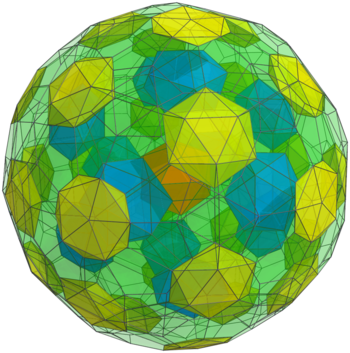The Truncated 600-cell
The truncated 600-cell is a beautiful uniform polychoron bounded by 120 icosahedra and 600 truncated tetrahedra, for a total of 720 cells, 3600 polygons (1200 hexagons and 2400 triangles), 4320 edges, and 1440 vertices. It can be obtained by truncating the 600-cell.
The above image shows the perspective projection of the truncated 600-cell into 3D, centered on an icosahedral cell. The nearest icosahedron to the 4D viewpoint is shown in orange. The next nearest 12 icosahedra are shown in blue, and the 32 yellow icosahedra are the next layer, lying close to the limb of the projection. The truncated tetrahedra are shown in transparent green. For the sake of clarity, the cells that lie on the far side of the truncated 600-cell have been omitted.
Structure
We shall explore the structure of the truncated 600-cell using its parallel projection into 3D, centered on an icosahedron.
First Layer
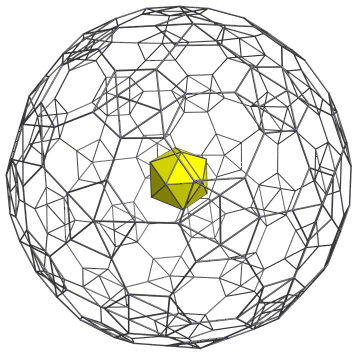
This image shows the nearest icosahedron to the 4D viewpoint, together with the edges on the truncated 600-cell's projection envelope. The other edges have been omitted for the sake of clarity. We may regard this cell as the “North Pole” cell.
Second Layer
Each triangular face of the “North Pole” icosahedron is joined to a truncated tetrahedron. There are 20 truncated tetrahedra in total. The following image shows 7 of these cells:
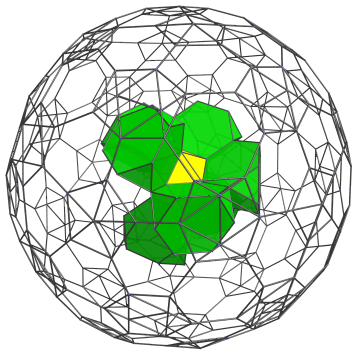
The next image shows another 7 of these cells:
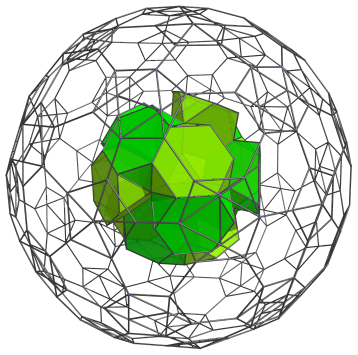
And here are all of them together:
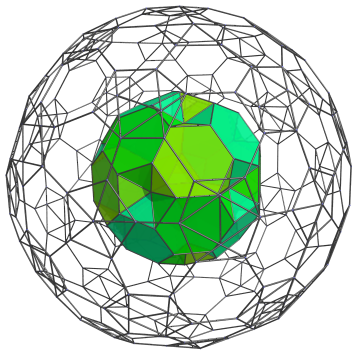
Third Layer
The little visible dents are filled in by 12 more icosahedra:
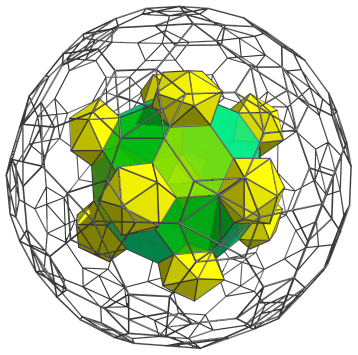
Joined to the visible hexagonal faces of the first layer of truncated tetrahedra are another 20 truncated tetrahedra:
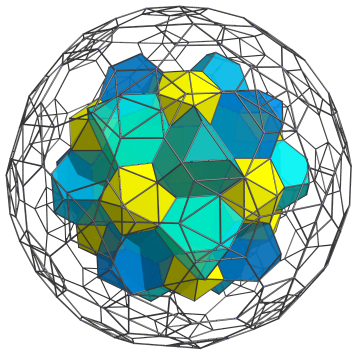
Straddling these truncated tetrahedra are 30 other truncated tetrahedra, as shown next:
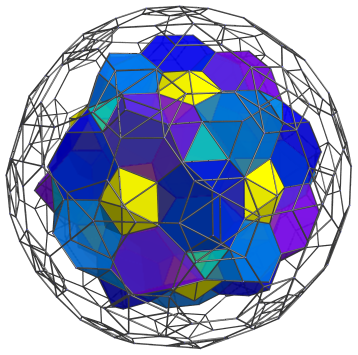
Fourth Layer
Another layer of 60 truncated tetrahedra are joined to the exposed triangular faces of the 12 icosahedra:
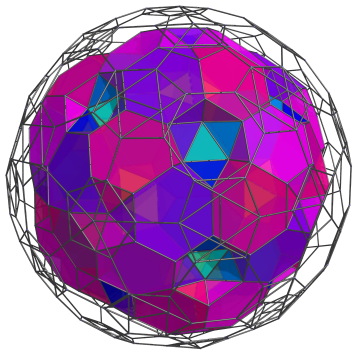
The icosahedral gaps visible are obviously filled in by icosahedral cells, 20 in total:
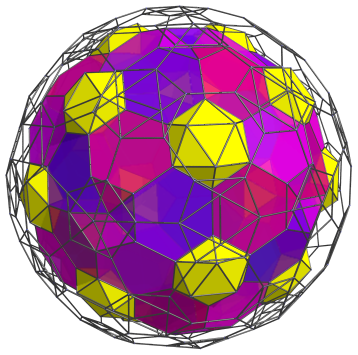
Fifth Layer
Another layer of 60 truncated tetrahedra lie on the hexagonal faces of the previous layer of truncated tetrahedra. They are shown below:
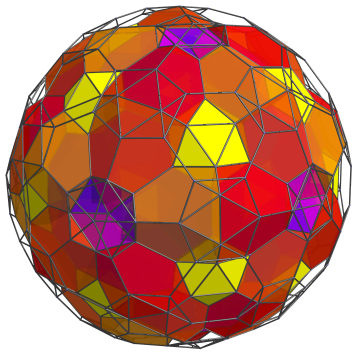
Twelve icosahedra fit into each circle of 5 truncated tetrahedra:
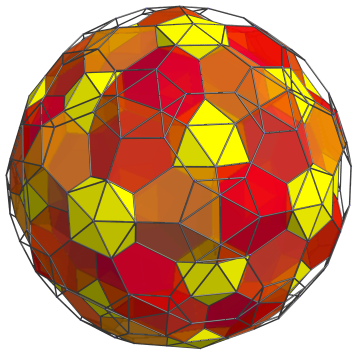
Surrounding each of these 12 icosahedra, straddling the circles of 5 truncated tetrahedra, is another layer of circles of 5 truncated tetrahedra, for a total of another 60 tetrahedra:
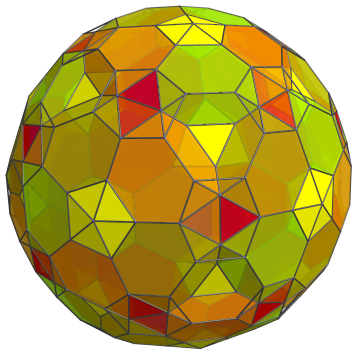
Another 20 truncated tetrahedra fit between these, touching the icosahedra from the previous layer:
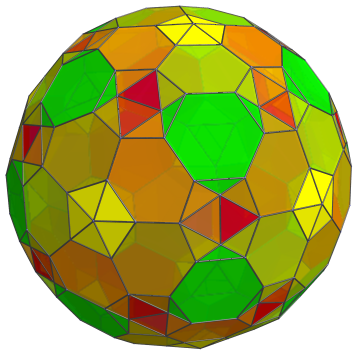
These are the last of the cells in the “Northern Hemisphere” of the truncated 600-cell.
The Equator
Now we come to the equator of the truncated 600-cell. There are 30 icosahedral cells that lie on the equator, as shown below:
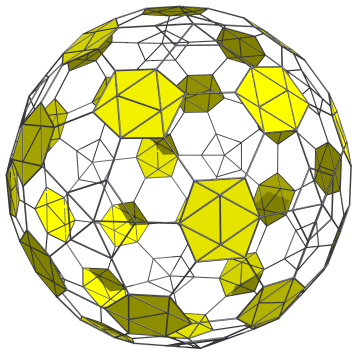
For the sake of clarity, we omit the “Northern Hemisphere” cells. These icosahedral cells have been foreshortened into hexagons because they are seen at a 90° angle. In reality, they are perfectly regular icosahedra.
There are also 60 truncated tetrahedra that lie on the equator. These are shown next:
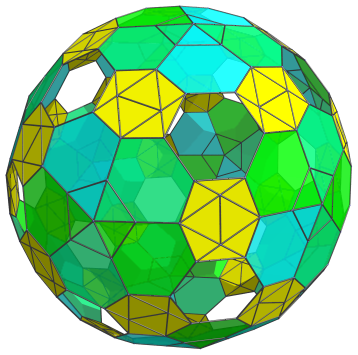
As can be seen, these truncated tetrahedra also occur in florets of 5 each. They have been foreshortened into irregular pentagons, because they are seen at a 90° angle. In 4D, they are perfectly uniform truncated tetrahedra.
The 20 hexagonal gaps do not correspond with any cell that lies on the equator; rather, they are the hexagonal faces where the last 20 truncated tetrahedra of the “Northern Hemisphere” touch with their corresponding counterparts in the “Southern Hemisphere”.
The cells in the “Southern Hemisphere” are laid out in exactly the same structure as in the “Northern Hemisphere”, except that the layers are reversed.
Summary
The following table summarizes the cell counts in each of the layers of the truncated 600-cell:
Coordinates
The Cartesian coordinates of the truncated 600-cell, centered on the origin and having edge length 2, are all even permutations of coordinates and all changes of sign of:
|
|
where φ=(1+√5)/2 is the Golden Ratio.
